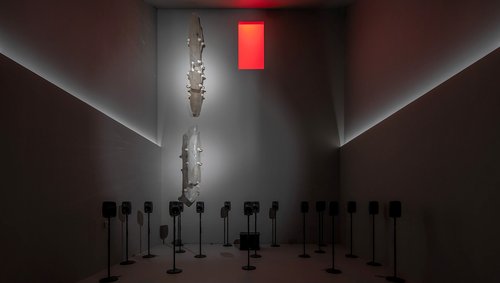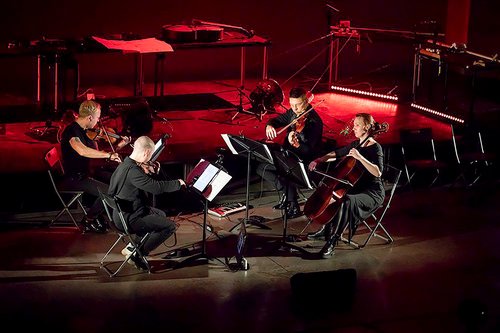The AZ/ART Centre: Are there Synergies Between Non-Conformist Art and Music?

Unobvious Intersections. Moscow, 2024. Courtesy of AZ/ART Centre for Contemporary Art
The AZ/ART Centre for Contemporary Art, a new branch of the AZ Museum, has opened in a historic 17th century building on Maroseyka Street in the centre of Moscow. With one of its two interior spaces repurposed for musical concerts, it seems this will be an institution which platforms both art and music.
The inaugural exhibition, ‘Unobvious Intersections’, explores the interaction between fine art and music and with support of the Nikolai Karetnikov Foundation it has been co-curated by executive director, Anton Karetnikov together with Natalia Opaleva, founder of the AZ Museum and the AZ/ART Centre, and Russian musicologist Sergei Terentiev.
According to the curators, the show presents “a subjective view of possible points of convergence and commonality between different creative methods, artistic means, imagery, language and plots in both works by Soviet unofficial artists and composers”. Their aim is to demonstrate “a vast panorama of intersections within the Second Avant-Garde”.
The avant-garde, experimental works by composer Nikolai Karetnikov (1930-1994) were derided by the Soviet authorities. Rather than become a slave to officialdom, he opted for internal emigration and now his son Anton Karetnikov is working to restore the reputation of his father. There are collaborative projects with the Moscow Philharmonic, such as the ‘Musica Sacra Nova. Spiritual Music from the former USSR’, which shows how composers born in an atheist country were able to find a musical language for religious music. The AZ/ART Centre's project perfectly aligns with the mission of the Nikolai Karetnikov Foundation, as it focuses on the Second Avant-Garde (although the musical programme is generally broader because it also includes works by major European and American composers from the post-war or neo-avant-garde school).
Refering to the title, specifically the choice of the word ‘Unobvious’ talking to Art Focus Now, Anton Karetnikov acknowledges that the project is speculative. It is not about matching a specific piece of music to a painting, there is freedom for the listener/viewer to judge the curators’ choice. There is at root is a kind of artistic dialogue resonating between the paired pieces of music and the art works.
Recently, interdisciplinary projects have become more popular. ‘Unobvious Intersections’ features ten paintings by artists from the 1960s which are displayed in the exhibition space for the duration of ten weeks. Each week the work of one of these ten artists is highlighted, a new artist – and theme – is launched with a concert featuring several works, so that the artist's work can be appreciated more fully. Following the launch, a recording of the music plays continuously in the exhibition space. There is a wide panoply of themes covered.
The theme ‘Music of the Spheres’ is dedicated to the art of women such as Lydia Masterkova (1927–2008), whose contemporaries often spoke of the musicality of her style. Her ‘Planets’ cycle reveals connections with Galina Ustvolskaya's (1919–2006) ‘Music of Spiritual Independence’. Ustvolskaya and Sofia Gubaidulina (b. 1931), another composer who feels the ‘vibrations of the universe’, are featured along with Masterkova’s work in ‘Music of the Spheres’.
‘Pax Americana’ draws parallels between Lev Kropivnitsky's (1922–1994) abstract expressionism and the music of such US composers as John Cage (1912–1992), Morton Feldman (1926–1987), and George Crumb (1929–2022), whose experimental works took the avant-garde to an extreme.
The curators highlight a link between ‘Concretions’ by Evgeny Mikhnov-Voytenko (1932-1988) and the twelve-note, dodecaphony technique pioneered by composers of the New Viennese School, which marked a final break with the classical-romantic harmony system. Here also the musical context extends beyond the boundaries of Russian music. The Studio for New Music ensemble played pieces by Arnold Schoenberg (1874-1951), Olivier Messiaen (1908-1992), Karlheinz Stockhausen (1928-2007), Nikolai Karetnikov and Boris Tishchenko (1939-2010)), all rooted in and inspired by the definitive break with romantic harmony. The forbidden fruit, once tasted, was discarded by some composers (whether of their own initiative or because it was dictated by the will of the Communist party) while it germinated in the works of others. Nikolai Karetnikov was among the latter. His commitment and desire to work in the dodecaphonic manner was stronger than the urge to hear his music performed in public.
Numbers, numerical series’, mathematical regularities in musical composition, one line of twentieth-century art, have matched Mikhail Chernyshov's (b. 1945) work ‘Doublings’ with music by Karetnikov and Gubaidulina. The primacy of rhythm is a link between Yuri Zlotnikov's (1930-2016) ‘Signals’ and works by Gubaidulina and Tishchenko. A sudden interest among leaders of the avant-garde in medieval music can be seen in paintings by Dmitry Plavinsky (1937-2012) which are partnered with melodies by Andrei Volkonsky (1933-2008), the composer and founder of the famous Madrigal ensemble. The theme of ‘Flora and Fauna’ by the artist Valentina Kropivnitskaya (1924-2008)) is captured in musical pieces by Valentin Silvestrov (b. 1937), Sergei Slonimsky (1932-2020), and the famous ‘Birdsong’ by Edison Denisov (1929-1996).
The attempt “to collide the satirical, grotesque element in music and the nightmarish anthropological reality touched upon in the works of Oleg Tselkov (1934-2021)” creates an inspired juxtaposition between his paintings and the music of avant-garde composer Alexander Mosolov (1900-1973) in ‘Four Newspaper Ads’ for voice and piano, and works by Dmitry Shostakovich (1906-1975) and Alfred Schnittke (1934-1998). Music by Gubaidulina and Denisov is paired with paintings by Vladimir Nemukhin (1925-2016). Finally, the cycle returns to the idea of the sacred, closing with the programme ‘Hymns and Hieratures’, combining Schnittke’s music with a painting by Mikhail Shvartsman (1926-1997).













